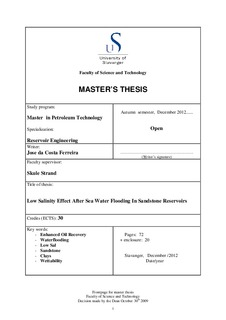| dc.contributor.author | Ferreira, Jose | |
| dc.date.accessioned | 2013-03-21T13:21:47Z | |
| dc.date.available | 2013-03-21T13:21:47Z | |
| dc.date.issued | 2012 | |
| dc.identifier.uri | http://hdl.handle.net/11250/183486 | |
| dc.description | Master's thesis in Petroleum engineering | no_NO |
| dc.description.abstract | Clays are the main wetting minerals and have permanently negative surface charges. The
negative charges must be balanced by; active cat ions, polar components or H+.
pH changes is observed in the effluent by flooding in a sequence of FW-SW-LS-FW. The
concentration of ions in the Low Salinity brine are lower than in the formation water and
sea water brines, especially Ca2+, Mg2+.
In the proposed chemical mechanism on Low Sal EOR effects in sandstone reservoir, it is
the effects of pH, both for the adsorption of acidic and basic organic components onto clay
minerals, to create initial low water wetness, and also for the desorption of the polar
components when the smart water is introduced.
When injecting Low Salinity fluid with low Ca2+ concentration, it will promote desorption of
Ca2+ from the clay surface which consequently creates a local increase in pH close to the
brine-clay interface due to H+ from the water compensates the negative charges at the clay
surface. A fast reaction between OH- and the absorbed acidic and protonated basic material,
it will cause desorption of organic material from the clay surface, and as the results, the
water wetness of the rock is improved and increased in oil recovery is observed due to
increased positive capillary pressure.
Mostly all sandstone reservoirs in North Sea have already been flooded with Sea Water. Is it
likely to observe Low Salinity EOR effect after the reservoir have been Sea Water flooded?
Through the combination of theoretical knowledge, and detailed low salinity experiments
carried out in the lab, both pH screening tests and oil recovery tests on reservoir cores
confirmed the possibility to observe Tertiary LS EOR effects in a High Temperature
Sandstone Reservoir. | no_NO |
| dc.language.iso | eng | no_NO |
| dc.publisher | University of Stavanger, Norway | no_NO |
| dc.relation.ispartofseries | Masteroppgave/UIS-TN-IPT/2012; | |
| dc.subject | petroleumsteknologi | no_NO |
| dc.subject | reservoarteknologi | no_NO |
| dc.subject | wettability | no_NO |
| dc.subject | sandstone | no_NO |
| dc.subject | waterflooding | no_NO |
| dc.subject | EOR | no_NO |
| dc.subject | enhanced oil recovery | no_NO |
| dc.subject | clay | no_NO |
| dc.title | Low salinity effect after sea water flooding in sandstone reservoirs | no_NO |
| dc.type | Master thesis | no_NO |
| dc.subject.nsi | VDP::Technology: 500::Rock and petroleum disciplines: 510::Petroleum engineering: 512 | no_NO |
